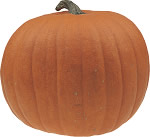 Pumpkin Lore And Culture - October 31, 2007 Jeff Schalau, Associate Agent, Agriculture & Natural Resources, Arizona Cooperative Extension, Yavapai County I hope that all readers have carved and prominently displayed their Halloween jack-o-lantern. People have been carving jack-o-lanterns for centuries. According to a Celtic myth, an unsavory character named “Stingy Jack” tricked the Devil into climbing a tree for a piece of fruit. Once the Devil was in the tree, Jack carved a sign of the cross into the tree trunk which prevented the Devil from coming down. Jack struck a deal with the Devil so that he could avoid going to hell. Before long, Jack died. God would not let such a scoundrel into heaven and the Devil would not allow him into hell. The Devil sent Jack on his way with an ember of coal. Jack placed the coal into a carved out turnip and has been roaming the earth ever since. Hence, “Jack of the lantern” or Jack O’Lantern. In Ireland and Scotland, people began to make their own versions of Jack’s lantern by carving scary faces into turnips or potatoes and placing them into windows or near doors to frighten away Stingy Jack and other wandering evil spirits. In England, large beets are used. Immigrants from these countries brought the jack-o-lantern tradition with them when they came to the United States. They soon found that pumpkins, a fruit native to America, made excellent jack-o-lanterns. Now we must have pumpkins and the seasonal agricultural phenomenon continues. Home gardeners often grow pumpkins. According to the University of Illinois Cooperative Extension, the F1 hybrid ‘Autumn Gold’ is one of the best to grow. The bright yellow immature pumpkins "stand out" amidst the green foliage. This early color allows an early harvest and a more flexible harvest time. Autumn Gold is a garden favorite from Canada to Texas. Two of the classic varieties are the ‘Connecticut Field’ and ‘Small Sugar’ or ‘New England Pie’. ‘Lumina’ is a popular white pumpkin variety. The ‘Atlantic Giant’ is the variety grown for largest pumpkins at the county fair. This variety holds the record at 1,689 pounds set on September 29, 2007 by Joe Jutras of Rhode Island. If that has you ready to plant, you’ll need to wait until next summer. Prepare soil by adding lots of compost and digging it in deep. Pumpkin seeds do not germinate in cold soil. In the Verde Valley, seed planting time would usually be in late May. Plant 4-5 seeds per mound and provide at least 50-100 square feet of space. Thin to the best two or three plants after young plant establish. Keep the area weeded and side dress with nitrogen fertilizer at mid-season. Irrigate regularly as you would for other warm season crops such as tomatoes or squash. Pumpkins can be harvested whenever they are a deep, solid color (orange for most varieties) and the rind is hard. If vines remain healthy, harvest in late September or early October, before heavy frosts. If vines die prematurely from disease or other causes, harvest the mature fruit and store them in a moderately warm, dry place until use. Cut pumpkins from the vines carefully, using pruning shears or a sharp knife and leave 3 to 4 inches of stem attached. Snapping the stems from the vines results in many broken or missing "handles." Pumpkins without stems usually do not keep well. Pumpkins are an excellent source of vitamin A with one pound of raw pumpkin containing 5,080 I.U. Seeds can also be roasted for a crunchy, nutritious snack. The hulls are a great source of fiber with the seeds containing a high amount of phosphorus. Pumpkin pulp makes great bread, soup, and pies. There are also seasonal beers that utilize pumpkin as a fermentable ingredient and are seasoned with pumpkin pies spices. So, I hope you get into the Halloween spirit by carving a pumpkin if for no other reason than to deter the spirit of Stingy Jack! For more great pumpkin information, check out the University of Illinois Extension Pumpkin Web Site at www.urbanext.uiuc.edu/pumpkins/. The University of Arizona Cooperative Extension has publications and information on gardening and pest control. If you have other gardening questions, call the Master Gardener line in the Cottonwood office at 646-9113 ext. 14 or E-mail us at cottonwoodmg@yahoo.com and be sure to include your address and phone number. Find past Backyard Gardener columns or submit column ideas at the Backyard Gardener web site: http://cals.arizona.edu/yavapai/anr/hort/byg/. |